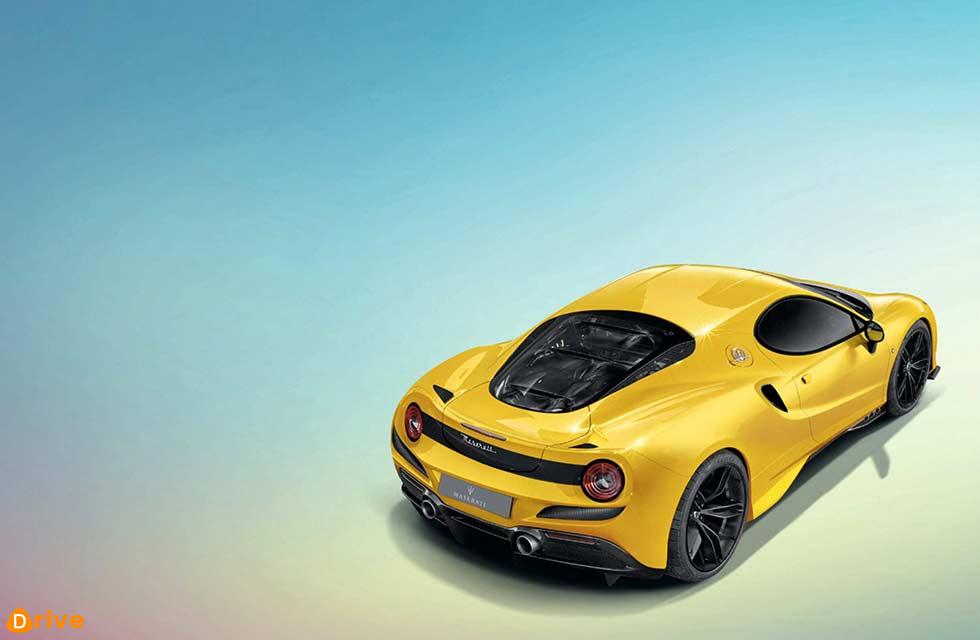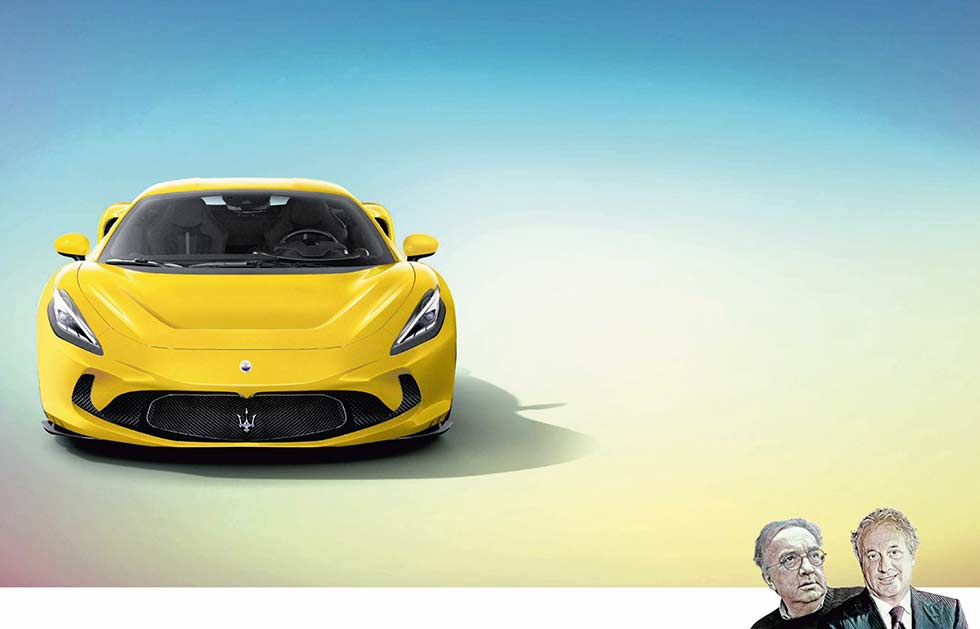Maserati had planned to kickstart its new sports-car era with the electric Alfieri. Instead its going big with a box-fresh mid-engined supercar called Supersportiva, due this year. Words Georg Kacher. Illustration Avarvarii.
ONE HELL OF A PLAN B Maserati’s new sports car
Maserati’s new supercar
SHOCK MASERATI SUPERCAR
HYBRID POWER! CARBON TUB! MEET THE MASER NO ONE SAW COMING
If this works, we’ll all be bowing down to the trend-bucking boldness of maverick Maserati. If, however, it all gets crushed or compromised by the mundane practicalities of the car industry in the 2020s… well, at least Maserati has maintained its glorious tradition of bringing a smile to the face of the car enthusiast, if not always the shareholder. What you see here is – according to inside sources – the new Maserati Supersportiva, a car nobody saw coming, for the very good reason that until recently it wasn’t in the plan.

The finished Supersportiva will be unveiled in May, and will go on sale before the end of the year witha price the right side of £200k. And we really like the sound of it: it’ll be powered by a mid-mounted V6 initially, with hybrid and full electric versions to follow. Incredible stuff – Maserati going up against the likes of Ferrari, Aston Martin and McLaren. Incredible too given that, until the summer of 2019 it was the all-electric Alfieri that was to lead Maserati’s next phase.
It uses an all-new carbonfibre tub baked to the same recipe as the feathery Alfa 4C
But Maserati isn’t the company it was as recently as last summer. Its parent company, FCA, is now in the process of being taken over by Groupe PSA, and it has a new brand boss. It also has a new plan, which involves not only the Supersportiva but also a brace of SUVs and – less certainly – a new saloon, coupe and cabrio, and a new approach to electrification.

As ever with Maserati, you need to read between the lines. The PR campaign for the Supersportiva kicked off with a handful of fuzzy after-dark teaser photos depicting a camouflaged two-seater with distinct Alfa 4C overtones. There was no explicit reference to this being a new car, just that it was a test mule for a new generation of Maserati powertrain. But the Supersportiva is likely to be put together on the same (if refurbished) assembly line as the 4C, which has just been discontinued.
The Supersportiva Trofeo gets a 700bhp-plus V6 and an electrified front axle
It will be longer, wider, sit on an extended wheelbase and feature a new carbonfibre tub compared with the 4C, though said tub will be baked to the same recipe as the feathery 65kg version co-developed with Dallara for the 4C. Our informants claim that both suspension modules will be redesigned (good news given the 4C’s obvious potential was scuppered by patchy dynamics) while an anti-roll bar is to be added at the rear. The broader-shouldered Maserati gains enough meat and muscle to accommodate a V6 engine mounted longitudinally.
So far, so plausible. But where exactly does the proprietary pace-setting engine come from, if it’s not an evolution of the Ferrari-built 2.9-litre V6 that develops 503bhp in the Alfa Quadrifoglio models? And we’re not talking any old twin-turbo V6 here. Required is a state-of-the-art newcomer that meets EU7 emissions regs and is, with or without a little electric help, good for between 600 and well over 700bhp.
Developing such an engine typically takes close to five years, and yet in this particular instance there is only a seven-month gap between the presentation and the scheduled start of production. One option would be to use the highly sophisticated and remarkably compact 120º 3.0-litre V6 that Ferrari is preparing for the Dino (F171) expected at the tail end of 2021. Trouble is, Ferrari has recently severed its ties to the lesser FCA brands and is highly unlikely to make an exception for the Supersportiva, which could be seen as a direct competitor. To solve the mystery, let’s go back to 2014 when Sergio Marchionne released a game plan for Alfa Romeo containing a new sports car earmarked for 2018. Three years later, the revised plan featured not one but two new high performers: the front-engined Alfa GTV and the 8C. We could be wide of the mark, but the Torinese grapevine insists the mid-engined Maserati uses an evolution of that GTV/8C engine, development of which began in 2017.

‘Displacement costs only pennies, but pays back big bucks in power and torque,’ said an FCA engineer when asked if there’s truth in the rumour Maserati is aiming for a capacity of 3.6 litres instead of the ubiquitous 3.0. Short- to mid-term, the new V6 is likely to be the Trident’s only engine, making the charismatic but dirty V8 obsolete. What it may lack in power and torque can easily be supplemented by e-modules (one between the engine and gearbox and another on the front axle). Eventually, there should be a scalable zero-emission drivetrain available for all Masers. Eventually…
While the front-engined GTV is obviously the wrong role model for the new Maserati, the designated 600bhp e-boost V6 earmarked for the Alfa remains a viable option. The more powerful Supersportiva Trofeo would benefit from a 700bhp-plus power pack which likely incorporates e-boosting for the V6 and an electrified front axle for improved all-wheel-drive traction and free-flow torque vectoring. According to a member of the supplier community, the base model is rear-wheel-drive only, does without electrification and comes equipped with a fast-shifting Getrag eight-speed dual-clutch transmission that Maserati is expected to share with Ferrari.
A GPF (gasoline particulate filter), pre-chamber direct-injection (instead of the heavyweight water injection) and sequential turbocharging (two separate chargers instead of a single twin-scroll unit) are also said to be part of the package.
When Alfa teased the 8C two years ago, it claimed a 0-62mph acceleration time of under 3 seconds. Thanks to adaptive aerodynamics including selectively blocked air intakes, adjustable underbody ground-effect flaps reminiscent of Lamborghini’s ALA system and a choice of maximum-downforce or minimum-drag set-ups, a top speed of 200mph is at least theoretically feasible. Trouble is, in two to three years from now, these numbers will no longer work as key deciders in the supercar segment, where Koenigsegg, Rimac, Pininfarina and Lotus can’t wait to bring 1500, 2000 or even more horsepower to the table.
At the same time, German Taycan and Tesla owners are bound to start clamouring for a nationwide speed limit as they discover that spending hours in the slipstream of Sprinter vans is not much fun. Maserati is promising us ‘traditional’ and ‘unique’ driving modes, but there is no word yet on the sort of digitalisation, personalisation and connectivity that increasingly matters to premium buyers.
Other key factors in an electrified environment that’s set to properly explode in 2022/2023 are best-in-segment range, fast inductive charging, top-notch repeatability, negligible degradation and early availability of solid-state batteries.
The Supersportiva will be the halo car, but Maserati’s big sellers should be a pair of SUVs. One is aimed squarely at the BMW X4, Mercedes GLC Coupe and future Audi Q6. It might be based on the Giorgio platform that also underpins the Alfa Stelvio, but is expected to be dimensionally closer to the current Levante than to the Alfa.
Today’s Levante is deemed to be too small for its price, so its replacement – due in 2023 – is set to grow closer to Q8/X6/GLE dimensions. It could sit on 2021’s next-generation Jeep Grand Cherokee underpinnings, or it could be on an evolution of the Giorgio platform.
Properly repositioned in two separate segments, the two soft-roaders are essential to stabilise the brand’s growing production volume. Even though Maserati is internally referring to the smaller of the two cars as ‘our Macan fighter’, the next Porsche Macan out in 2022 goes fully electric from day one – while Maserati will at best offer a PHEV option by then.
Doubling the SUV presence is a shrewd move fully supported by the FCA CEO Mike Manley, as is the intention to cut the number of four-door saloons from two to one. You see, last year, the luxury car maker sold only 2460 Quattroporte models worldwide – with a choice of three different engines and various equipment packs. This is obviously not a viable business case, but switching the focus to the Ghibli, which found 8136 takers, also looks more like a cul-de-sac than an escape route. Not surprisingly, product planning pitched the idea to fuse both products. The result is said to be only a little shorter than the Quattroporte and consequently quite a bit roomier than the Ghibli. Although the combined projected volume is optimistically pegged at 15,000 units by 2024, there is no budget for a long-wheelbase version, which would be nice to have in China and the US.
Perhaps Maserati should instead consider ditching three-box saloon designs altogether in favour of a GranFuoristrada cruiser shaped along the crossover lines of the 2019 Lagonda shooting brake and the 2019 Cadillac EV concept.
Last but not least, let’s look at the replacements for GranTurismo/ GranCabrio due in 2021 and 2022 respectively. The first question that comes to mind is why bother? After all, the two Mk1 body styles based on the fifth-generation Quattroporte out in 2003 took a dozen years to accumulate 40,000 sales – less than 3400 hits per annum for both versions combined. Which leads straight to the second question: how is Maserati supposed to warrant a positive return on investment with regard to a new upmarket 2+2-seater engineered to also work as PHEV and EV when not even Mercedes succeeds? Merc currently sells around 6000 two-door S-Class internal-combustion-only models per year and yet plans to abandon the segment.
In an ideal world, Maserati’s plug-in hybrid offerings would be good for EV-only ranges of between 30 and 60 miles. In this ideal world, the marque will start its e-venture with 400 volts across the board and then upgrade to 800 volts for sub-20-minute quick charges. Since all listed future Masers are to debut before 2023, we expect conventional lithium-ion energy cells in, say, three versions rated at around 80/120/160kWh for ranges of 250/310/380 miles and a maximum charge power of 250kW, eventually increasing to 350kW.
The Supersportiva is an exciting project that should do really well for the brand – as long as it pleases the eye and delivers the goods. Done right, the new Levante and the D-SUV should be described as licences to print money. But I’m less confident about the other three proposals. Perhaps Maserati should consider grouping coupe, cabrio and saloon under one umbrella, as BMW does with the 8-series. Alternatively, it may be worth taking the risk and trying something completely out of the box, like a mould-breaking five-door coupe/shooting brake hybrid and a full-size luxury SUV/saloon hybrid. Worth a punt, we’d have thought, for a brand that prides itself on being different from the premium norm. The last thing Il Tridente should be making is copycat new cars. Let’s hope the new FCA/ PSA board allows Maserati enough freedom to go its own way, without too much DNA having to be shared with other parts of the group.
MASERATI’S MASTERMINDS
The late Sergio Marchionne’s shadow still looms large in Modena. Although the FCA group chief (left) died in 2018, his ambitious plans for Maserati continue to prove difficult to deliver. Reid Bigland (2016-2018) and Tim Kuniskis (2018- 2019), ably assisted by technical chief Harald Wester, tried to implement those plans, but sales nonetheless tumbled to a paltry 24,000 units in 2019. Last summer the baton passed to new chief operating officer Davide Grasso (right). Although born in Turin, he’s an automotive-industry outsider, and has proved his talent with a series of senior global roles with Converse, part of the Nike empire.





